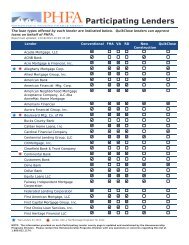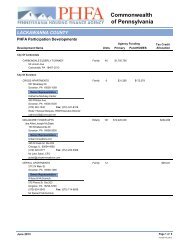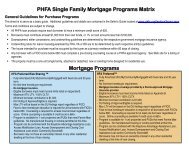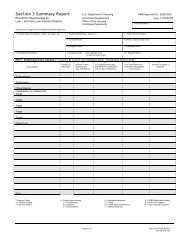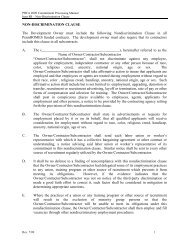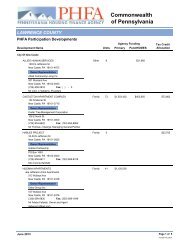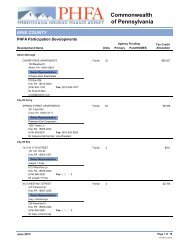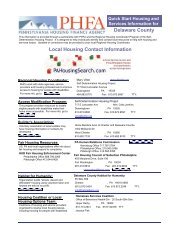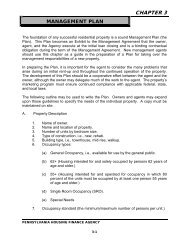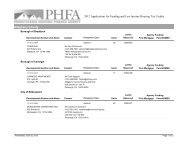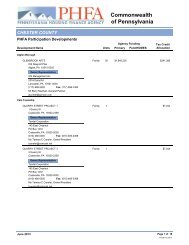PHFA Annual Report 2003 - Pennsylvania Housing Finance Agency
PHFA Annual Report 2003 - Pennsylvania Housing Finance Agency
PHFA Annual Report 2003 - Pennsylvania Housing Finance Agency
Create successful ePaper yourself
Turn your PDF publications into a flip-book with our unique Google optimized e-Paper software.
28 29<br />
FINANCIAL ANALYSIS<br />
MANAGEMENT’S DISCUSSION AND ANALYSIS<br />
(in thousands of dollars)<br />
June 30, <strong>2003</strong> Prepared by the <strong>Finance</strong> Division Brian Hudson<br />
CPA, Executive Director<br />
This discussion and analysis is designed to assist the reader in focusing on significant financial issues and activities and to identify<br />
any significant changes in financial position of the <strong>Pennsylvania</strong> <strong>Housing</strong> <strong>Finance</strong> <strong>Agency</strong> (“the <strong>Agency</strong>”). Readers are encouraged<br />
to consider the information presented in conjunction with the financial statements as a whole, which follow this section.<br />
BASIC FINANCIAL STATEMENTS<br />
The basic financial statements include three required statements, which provide different views of the <strong>Agency</strong>. They are the statement<br />
of net assets, the statement of revenues, expenses and changes in net assets and the statement of cash flows. These statements<br />
provide current and long-term information about the <strong>Agency</strong> and its activities. These financial statements report information using<br />
accounting methods similar (although not identical) to those used by private sector companies. The statement of net assets<br />
includes all assets, liabilities and net assets as of the fiscal year-end date. The statement of revenues, expenses and changes in net<br />
assets presents all the current fiscal year’s revenues and expenses, and presents net income and the resulting change in net assets. If<br />
revenues exceed expenses, the result is income which, when added to the net assets at the beginning of the year, increases the net<br />
assets of the <strong>Agency</strong>. If expenses exceed revenues, the result is a loss and when subtracted from the beginning net assets would<br />
result in a decrease of net assets. The final required statement is the statement of cash flows. This statement reports cash receipts,<br />
disbursements and the net change in cash resulting from the principal types of activities; operating activities, financing activities<br />
and investing activities. These categories provide answers to such questions as where did cash come from, what was cash used for<br />
and what was the change in the cash balance during the fiscal year.<br />
In order for the basic financial statements to be complete, they must be accompanied by a complete set of footnotes and required<br />
supplemental information (“RSI”). The footnotes (or notes) provide disclosures which are required to conform with generally<br />
accepted accounting principles (“GAAP”). The <strong>Agency</strong> has adopted accounting standards promulgated by the Government<br />
Accounting Standards Board (“GASB”). The driving force behind this expanded Management’s Discussion and analysis is GASB<br />
Number 34, Basic Financial Statements and Management’s Discussion and Analysis for State and Local Governments, which the<br />
<strong>Agency</strong> adopted in the prior fiscal year. The <strong>Agency</strong> also adopted GASB Number 37 and 38, which together define RSI to include<br />
this discussion section as well as the Schedule of Funding Progress and Contributions from the Employer and Other Contributing<br />
Entities.<br />
The financial analysis presented below, based on the programs of the <strong>Agency</strong> for the fiscal year ended June 30, <strong>2003</strong>, should be<br />
read in conjunction with the financial statements which begin after this section. The amounts below have been presented in thousands<br />
to facilitate reading of this analysis.<br />
During the fiscal year ended June 30, <strong>2003</strong>, the <strong>Agency</strong>’s combined total assets, consisting primarily of mortgage loan receivables<br />
and investment securities, increased by approximately 3.6 percent, to $3,991,966 from $3,855,076, a $136,890 increase. During<br />
the fiscal year ended June 30, 2002, combined total assets grew by $78,192, approximately a 2.1 percent increase. The reported<br />
total combined net income after extraordinary items increased total net assets by approximately $23,401, to $602,230 at June 30,<br />
<strong>2003</strong> from $578,828 at June 30, 2002.<br />
The <strong>Agency</strong>’s combined income before extraordinary items for the fiscal year ended June 30, <strong>2003</strong>, was $24,668, as compared with<br />
$16,461 in the prior year. The $8,207 increase in income before extraordinary items resulted primarily from changes in the following<br />
items: The provision for loan loss allowance was only $8,878, compared to the prior year’s provision of $15,794. Loan loss<br />
provisions are charged against income and are based on study and analysis by management. The realized gain on the sale of investments<br />
increased by approximately $2,011 over the prior year. Gains are realized when the investment’s selling value exceeds the<br />
book value. The investment portfolio increased in value by $5,581 during the period, as compared to a gain of only $757 in 2002.<br />
Also driving the increase was a decrease in interest expense of $5,712 when compared to the prior year. This is due to the low<br />
interest rate environment.<br />
Loan Portfolios<br />
The Multi-Family construction and mortgage loans, the Single Family mortgage loans and the HEMAP mortgage loans are the<br />
<strong>Agency</strong>’s primary assets. These include $510,009 of Multi-Family Program loans, $2,012,952 of Single Family Program loans and<br />
$49,183 of HEMAP mortgage loans. A reduction in the mortgage loan portfolios occurred due to repayments and payoffs exceeding<br />
construction and mortgage loan advances and new purchases of loans. For the fiscal year ended June 30, <strong>2003</strong> the following<br />
are key highlights of loan related activities:<br />
• The <strong>Agency</strong> funded approximately $18,070 of Multi-Family Program loans. However, the Multi- Family portfolio decreased to<br />
$510,009 as of June 30, <strong>2003</strong>, from $526,701 as of June 30, 2002 after adjustments for normal principal amortization payments<br />
and the prepayments of several mortgage loans.<br />
• The Single Family Program purchased approximately $192,496 of new mortgage loans. However, the Single Family portfolio<br />
decreased to $2,012,952 as of June 30, <strong>2003</strong>, from $2,242,000 as of June 30, 2002 as a result of scheduled mortgage payments<br />
and prepayments. Single Family borrowers prepaid approximately $403,881 of loans during fiscal year <strong>2003</strong> due to reduced<br />
interest rates in the conventional mortgage marketplace.<br />
• The HEMAP Program disbursed approximately $12,906 of loans during the year, however the portfolio decreased to $49,183 as<br />
of June 30, <strong>2003</strong>. The decrease is due to principle payments and loan write-offs during the year.<br />
Financing Activity<br />
During the current fiscal year, total combined liabilities increased by $113,488, as a result of net issuance of long-term bonds in<br />
order to provide funding required to originate and purchase mortgages. Total combined long-term debt outstanding, net of discounts<br />
and deferred losses on refundings, increased by $93,842 during the fiscal year ended June 30, <strong>2003</strong>.



